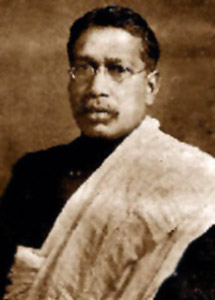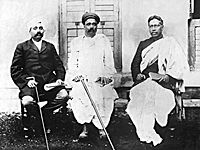Bipin Chandra Pal
This article needs additional citations for verification. (December 2019) |
Bipin Chandra Pal | |
|---|---|
 | |
| Born | 7 November 1858 |
| Died | 20 May 1932 (aged 73) Calcutta (now Kolkata), British India |
| Nationality | Indian |
| Alma mater | University of Calcutta |
| Occupation(s) | Politician Writer Indian independence movement activist Orator Social reformer |
| Organization | Brahmo Samaj |
| Political party | Indian National Congress |
| Movement | Indian Independence movement |
| Signature | |
Bipin Chandra Pal (Bengali: বিপিন চন্দ্র পাল ; 7 November 1858 – 20 May 1932) was an Indian nationalist, writer, orator, social reformer and Indian independence movement freedom fighter. He was one third of the “Lal Bal Pal” triumvirate.[1] Pal was one of the main architects of the Swadeshi movement along with Sri Aurobindo. He stood against the partition of Bengal by the colonial British government.
Early life and background
Bipin Chandra Pal was born in the village of Poil, Habiganj, Sylhet District, Bengal Presidency of British India, in a Hindu Bengali Kayastha family.[2] His Sylheti father was Ramchandra Pal, a Persian scholar, and small landowner. He studied and taught at the Church Mission Society College (now the St. Paul's Cathedral Mission College), an affiliated college of the University of Calcutta.[3] His son was Niranjan Pal, one of the founders of Bombay Talkies. His son-in-law was the ICS officer, S. K. Dey, who later became a union minister. His another son-in-law was freedom fighter Ullaskar Dutta who married Lila Dutta his childhood love interest after many circumstances at their last age.
As revolutionary as he was in politics, Pal was the same in his private life as well. After his first wife died, he married a widow and joined the Brahmo Samaj.[4]
Work

Pal is known as the Father of Revolutionary Thoughts in India and was one of the freedom fighters of India.[5] Pal became a major leader of the Indian National Congress. At the Madras session of Indian National Congress held in 1887, Bipin Chandra Pal made a strong plea for repeal of the Arms Act which was discriminatory in nature. Along with Lala Lajpat Rai and Bal Gangadhar Tilak he belonged to the Lal-Bal-Pal trio that was associated with revolutionary activity. Sri Aurobindo Ghosh and Pal were recognised as the chief exponents of a new national movement revolving around the ideals of Purna Swaraj, Swadeshi, boycott and national education. His programme consisted of Swadeshi, boycott and national education. He preached and encouraged the use of Swadeshi and the boycott of foreign goods to eradicate poverty and unemployment. He wanted to remove social evils from the form and arouse the feelings of nationalism through national criticism. He had no faith in mild protests in the form of non-cooperation with the British colonialists. On that one issue, the assertive nationalist leader had nothing common with Mahatma Gandhi. During the last six years of his life, he parted company with the Congress and led a secluded life. Sri Aurobindo referred to him as one of mightiest prophets of nationalism. Bipin Chandra Pal made his efforts to remove social and economic ills. He opposed caste system and advocated widow remarriage. He advocated 48 hours of work week and demanded for the hike in wages of workers. He expressed his disdain for Gandhi's ways, which he criticised for being rooted in “magic” instead of “logic”.[4]
As a journalist, Pal worked for Bengal Public Opinion, The Tribune and New India, where he propagated his brand of nationalism.[6] He wrote several articles warning India of the changes happening in China and other geopolitical situations. In one of his writings, describing where the future danger for India will come from, Pal wrote under the title "Our Real Danger".[7]
-
Lala Lajpat Rai of Punjab, Bal Gangadhar Tilak of Maharashtra, and Bipin Chandra Pal (right) of Bengal, the triumvirate were popularly known as Lal Bal Pal, changed the political discourse of the Indian independence movement.
References
- ^ Ashalatha, A.; Koropath, Pradeep; Nambarathil, Saritha (2009). "Chapter 6 – Indian National Movement" (PDF). Social Science: Standard VIII Part 1. State Council of Educational Research and Training (SCERT). p. 72. Retrieved 13 October 2011.
{{cite book}}:|work=ignored (help) - ^ M.K. Singh (2009). Encyclopedia Of Indian War Of Independence (1857–1947). Anmol Publications. p. 130.
Bipin Chandra Pal (1858–1932) a patriot, nationalist politician, renowned orator, journalist, and writer. Bipin Chandra Pal was born on 7 November 1858 in Sylhet in a wealthy Hindu Kayastha family
- ^ "List of distinguished alumni". Archived from the original on 25 September 2012. Retrieved 22 December 2019.
- ^ a b "Bipin Chandra Pal: As much a revolutionary in politics, as in his private life". 12 January 2020. Archived from the original on 12 January 2020. Retrieved 21 March 2020.
- ^ "Bipin Chandra Pal". youtube. 19 May 2014.
- ^ Sequeira, Dolly (2018). Total History & Civics. India: Morning Star (A unit of MSB Publishers Pvt. Ltd). p. 53.
- ^ Madhav, Ram (2014). Uneasy neighbours : India and China after 50 years of the war. New Delhi: Har-Anand Publications. pp. 10, 11, 12. ISBN 978-81-241-1788-0.
Further reading
- Owen, N (2007), The British Left and India, Oxford University Press, ISBN 978-0-19-923301-4
- Lenman, Bruce; Marsden, Hilary, eds. (2005). Chambers Dictionary of World History. London: Chambers Harrap. ISBN 978-0-550-10094-8 – via Credo Reference.
- Pal, Bipin Chandra (1916), Nationality and Empire, Thacker, Spink & Co / Low Price Publications, ISBN 81-7536-274-X
- 1858 births
- 1932 deaths
- People from Habiganj Sadar Upazila
- 20th-century Bengalis
- 19th-century Bengalis
- Indian independence activists from Bengal
- India House
- Brahmos
- St. Paul's Cathedral Mission College alumni
- University of Calcutta alumni
- University of Calcutta faculty
- Members of Central Legislative Assembly of India
- Revolutionaries from West Bengal

